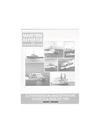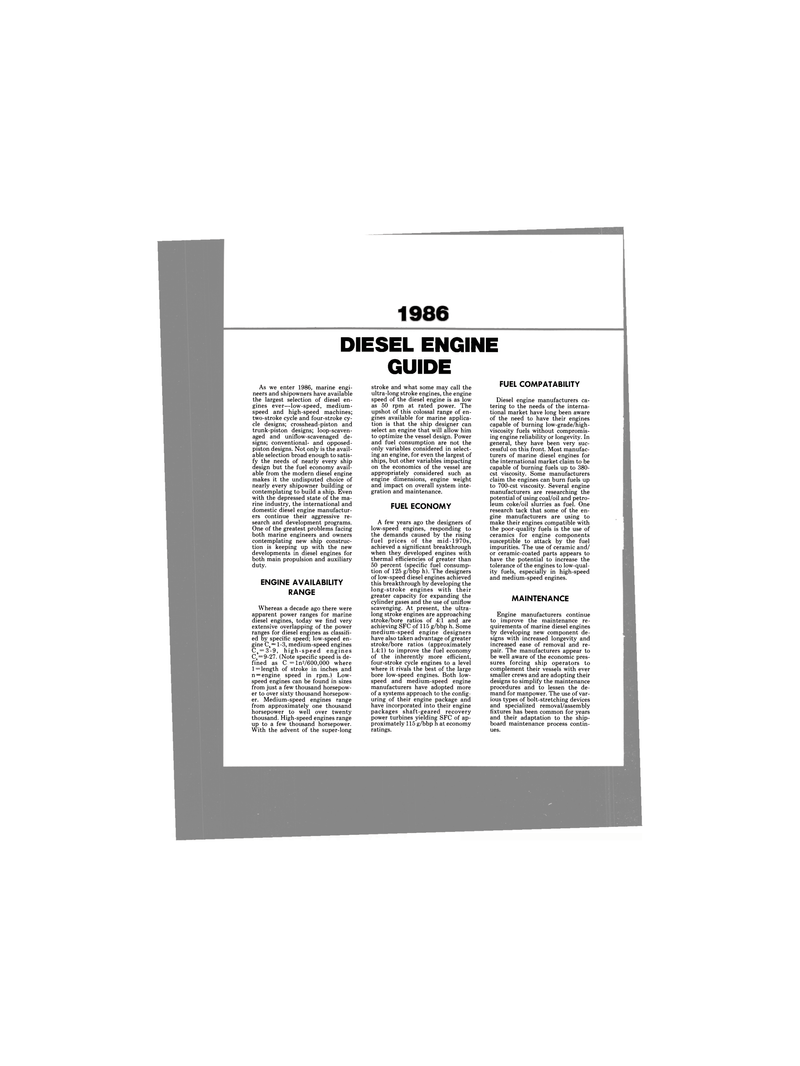
Page 28: of Maritime Reporter Magazine (January 1986)
Read this page in Pdf, Flash or Html5 edition of January 1986 Maritime Reporter Magazine
1986
DIESEL ENGINE
GUIDE
As we enter 1986, marine engi- neers and shipowners have available the largest selection of diesel en- gines ever—low-speed, medium- speed and high-speed machines; two-stroke cycle and four-stroke cy- cle designs; crosshead-piston and trunk-piston designs; loop-scaven- aged and uniflow-scavenaged de- signs; conventional- and opposed- piston designs. Not only is the avail- able selection broad enough to satis- fy the needs of nearly every ship design but the fuel economy avail- able from the modern diesel engine makes it the undisputed choice of nearly every shipowner building or contemplating to build a ship. Even with the depressed state of the ma- rine industry, the international and domestic diesel engine manufactur- ers continue their aggressive re- search and development programs.
One of the greatest problems facing both marine engineers and owners contemplating new ship construc- tion is keeping up with the new developments in diesel engines for both main propulsion and auxiliary duty.
ENGINE AVAILABILITY
RANGE
Whereas a decade ago there were apparent power ranges for marine diesel engines, today we find very extensive overlapping of the power ranges for diesel engines as classifi- ed by specific speed; low-speed en- gine Cs=l-3, medium-speed engines
Cs=3-9, high-speed engines
Cs = 9-27. (Note specific speed is de- fined as C. = ln2/600,000 where 1 = length of stroke in inches and n = engine speed in rpm.) Low- speed engines can be found in sizes from just a few thousand horsepow- er to over sixty thousand horsepow- er. Medium-speed engines range from approximately one thousand horsepower to well over twenty thousand. High-speed engines range up to a few thousand horsepower.
With the advent of the super-long stroke and what some may call the ultra-long stroke engines, the engine speed of the diesel engine is as low as 50 rpm at rated power. The upshot of this colossal range of en- gines available for marine applica- tion is that the ship designer can select an engine that will allow him to optimize the vessel design. Power and fuel consumption are not the only variables considered in select- ing an engine, for even the largest of ships, but other variables impacting on the economics of the vessel are appropriately considered such as engine dimensions, engine weight and impact on overall system inte- gration and maintenance.
FUEL ECONOMY
A few years ago the designers of low-speed engines, responding to the demands caused by the rising fuel prices of the mid-1970s, achieved a significant breakthrough when they developed engines with thermal efficiencies of greater than 50 percent (specific fuel consump- tion of 125 g/bbp h). The designers of low-speed diesel engines achieved this breakthrough by developing the long-stroke engines with their greater capacity for expanding the cylinder gases and the use of uniflow scavenging. At present, the ultra- long stroke engines are approaching stroke/bore ratios of 4:1 and are achieving SFC of 115 g/bbp h. Some medium-speed engine designers have also taken advantage of greater stroke/bore ratios (approximately 1.4:1) to improve the fuel economy of the inherently more efficient, four-stroke cycle engines to a level where it rivals the best of the large bore low-speed engines. Both low- speed and medium-speed engine manufacturers have adopted more of a systems approach to the config- uring of their engine package and have incorporated into their engine packages shaft-geared recovery power turbines yielding SFC of ap- proximately 115 g/bbp h at economy ratings.
FUEL COMPATABILITY
Diesel engine manufacturers ca- tering to the needs of the interna- tional market have long been aware of the need to have their engines capable of burning low-grade/high- viscosity fuels without compromis- ing engine reliability or longevity. In general, they have been very suc- cessful on this front. Most manufac- turers of marine diesel engines for the international market claim to be capable of burning fuels up to 380- cst viscosity. Some manufacturers claim the engines can burn fuels up to 700-cst viscosity. Several engine manufacturers are researching the potential of using coal/oil and petro- leum coke/oil slurries as fuel. One research tack that some of the en- gine manufacturers are using to make their engines compatible with the poor-quality fuels is the use of ceramics for engine components susceptible to attack by the fuel impurities. The use of ceramic and/ or ceramic-coated parts appears to have the potential to increase the tolerance of the engines to low-qual- ity fuels, especially in high-speed and medium-speed engines.
MAINTENANCE
Engine manufacturers continue to improve the maintenance re- quirements of marine diesel engines by developing new component de- signs with increased longevity and increased ease of removal and re- pair. The manufacturers appear to be well aware of the economic pres- sures forcing ship operators to complement their vessels with ever smaller crews and are adopting their designs to simplify the maintenance procedures and to lessen the de- mand for manpower. The use of var- ious types of bolt-stretching devices and specialized removal/assembly fixtures has been common for years and their adaptation to the ship- board maintenance process contin- ues.

 27
27

 29
29
